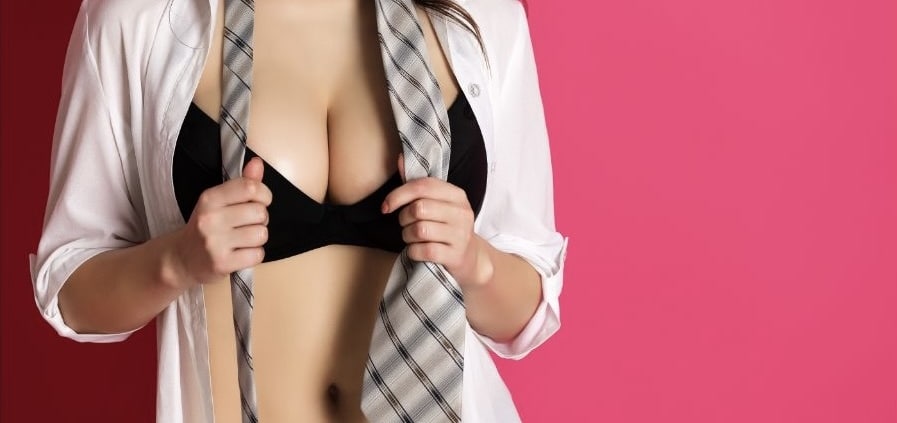How Noticeable Are Breast Reduction Scars?
For many women considering a San Francisco breast reduction surgery, one of the most significant concerns is the visibility of scars post-surgery. Understanding the nature of breast reduction scars and the original incisions as well as the healing process and strategies for minimizing scars can help alleviate these concerns and provide a clear picture of what to expect.
Breast Reduction Incisions
Breast reduction surgery requires making incisions on the breasts to remove excess breast tissue, skin, and fat. The breasts are then reshaped into a smaller, more proportionate size. Where your particular incisions are located and what exactly they look like depends on the specific technique used by your plastic surgeon.
The following is a list of the most typical breast reduction incision patterns.
Anchor Incision Pattern (Inverted T)
The anchor incision pattern requires one incision across the breast crease (inframammary fold), another up the bottom of the breast (vertically), and a final incision around the outer edge of the areola.
Lollipop Incision Pattern (Vertical)
With the lollipop or vertical incision method, incisions are made vertically down the lower portion of the breast and around the outer edge of the areola.
Periareolar Incision Pattern (Donut)
Lastly, the periareolar approach requires making an incision around the outer edge of the areolae. Typically, these incisions (and the subsequent scars) blend nicely with the pigment change from the darker areolae to the natural skin tone.
Which Breast Reduction Incision Pattern Is Best?
Your choice of incision pattern depends mostly on how much redundant skin, tissue, and fat you have and, of course, your desired outcome. Some plastic surgeons are also partial to certain incision patterns, so they will weigh in on the method they think is best suited for you.
If you only require a modest amount of excess skin and tissue removal, the lollipop or vertical incision patterns may be good for you. For more extensive tissue and skin removal, you may require the anchor incision pattern.
Breast Reduction Scarring
What Do Breast Reduction Scars Look Like Right After Surgery?
Immediately following your breast reduction surgical procedure, scars are typically red, swollen, and may appear raised or slightly puckered. These symptoms are to be expected. They are a natural part of the healing process.
What Do Healed Breast Reduction Surgery Scars Look Like?
With your breast reduction scars healed, you’ll notice a drastic difference in appearance. After one year breast reduction scars are typically flattened and faded. They may change color and become a bit more mauve or grayish pink as they blend in with the surrounding skin. While some scars may remain visible, you’ll be able to easily conceal them beneath most clothing and even small swimwear.
Will Breast Reduction Scars Ever Go Away?
Many patients want to know, “Are breast reduction scars permanent?”
And the answer is yes, they are. Unfortunately, if you want a scarless breast reduction, you’re simply not going to get the same great results. Surgical breast reduction procedures achieve outstanding results, but they require incisions, which means scarring.
But there’s good news too. While breast reduction scars may never completely disappear, they often become much less noticeable with time. Proper scar care and management can also help minimize their appearance and promote optimal healing. Finally, the typical clothes you wear on a daily basis will almost surely cover your scars.
How to Minimize Breast Reduction Scars: Top Tips
Use the following tips to help reduce the appearance of scar tissue after your breast reduction procedure.
Follow your surgeon’s recovery directions.
In order to achieve optimal results, you must follow your surgeon’s recovery instructions. Sleep, move, eat, and care for your incision areas just the way your surgeon instructs.
 Keep scars out of the sun.
Keep scars out of the sun.
Heading out in the sun after your surgery can make scarring worse. Protect your skin with SPF (after healing) and clothing. Stay in the shade, and definitely avoid intentional tanning.
Use scar creams or silicone sheets.
Using silicone scar gels or silicone sheets as recommended by your plastic surgeon can help soften and flatten scars to a more natural skin tone.
Try scar massage.
Gentle massaging of the scar tissue around your surgical incisions can improve circulation and promote healing. This is something to speak with your surgeon about prior to your procedure so you can hit the ground running with massage when possible.
Consider scar revision surgery if needed.
In some cases, scar revision surgery may be necessary. This could involve steroid injections, laser treatments, or even additional cosmetic surgery depending on the severity of your initial scars.
FAQ: Breast Reduction Surgery Scars
Do breasts look better after reduction?
Yes, the primary goal of breast reduction surgery and lift is to relieve the patient of the discomfort associated with having overly large breasts. However, we also want you to look and feel your best. Therefore, we always aim to achieve a more balanced, proportionate appearance and to help your breasts look lifted and perky in all the right places.
What are keloid scars?
Keloid scars are thick, raised scars. Their hallmark sign is extending beyond the boundaries of the original incision site. Some patients with naturally darker skin tones may have a propensity for developing keloid scars.
What are hypertrophic scars?
Hypertrophic scars are similar to keloid scars. However, they usually stay within the boundaries of the original incision. They are raised and hyper-pigmented and can be treated with laser therapy.
What are the pros and cons of breast reduction surgery?
There are both a few pros and cons of breast reduction surgery. This procedure can alleviate discomfort, improve posture, and boost self-esteem. However, it involves risks like scarring, potential loss of nipple sensation, and complications such as infection or asymmetry.
Schedule a Consultation Today with Dr. Sieber
Many patients are happy to find out that they are excellent candidates for breast reduction surgery and that, in fact, the scars they will have should hardly be visible after healing.
If you are considering a breast reduction, please contact our San Francisco office today to set up your first consultation appointment with board certified plastic surgeon Dr. David Sieber. We look forward to hearing from you.





 Keep scars out of the sun.
Keep scars out of the sun.